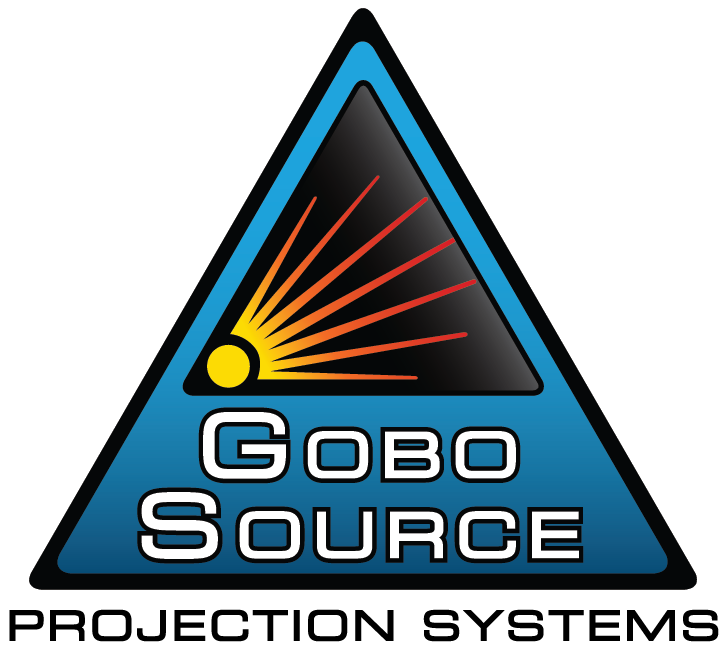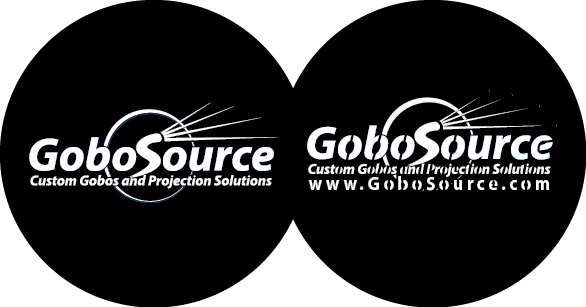
Updated January 21, 2019
When choosing a gobo type it’s important to know the difference between glass, metal, and film. Many customers will automatically choose metal or film for the cheaper price point, but there are many reasons to invest more up front and go with glass. Read on to understand the differences between these three gobo types:
How each gobo is made
The main difference between glass, metal, and film gobos comes down to how the artwork is transferred onto the plate.
For glass gobos, the design is etched either chemically or with a laser onto thin glass plates. This allows for highly detailed, photo-realistic artwork in black & white, grayscale, or color.
Metal gobos are cut into a thin metal plate. Just like a stencil, metal requires tabbing or bridging. This means you will see a thin line of metal break up certain letters and designs in order for the design to hold together.
Film gobos are printed like an overhead transparency onto a piece of film. These can accommodate full color, except that colors projected through film are muted and less saturated compared to glass. For example, you’ll never achieve as deep of a black as glass because the film lets more light through. You can technically print these yourself, but a high definition printer and a special type of film is required. Film gobo projections will also appear pixelated compared to glass gobos.
So when should you use each type of gobo? Let’s take a look at the different applications for each:
Glass Gobos
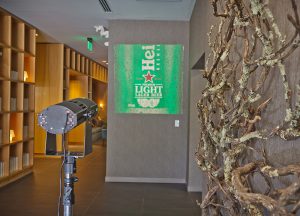
Translate complex designs, custom artwork & logos into photo-realistic projections
Glass provides the highest quality image for the widest variety of applications. We use the highest resolution lasers to create photo-realistic projections, bringing custom (or stock) designs to life. Even intricate, complex designs can be recreated to match your original artwork, whether it’s a wedding monogram with flowing script or a detailed abstract pattern. For company logos, glass allows you to stay true to the design and font, ensuring your branding stays consistent across applications.
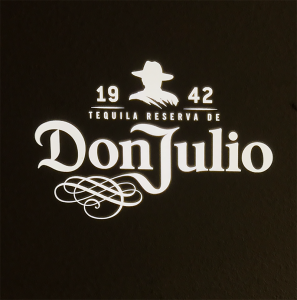
Accuracy and fast production times
The accuracy provided by laser technology often removes the need for proofs with glass gobos, significantly cutting down on production time. Metal gobos often require several adjustments or simplifications to the original artwork before achieving a satisfactory result.
Even with an intricate or complex design, glass gobos usually don’t require alterations to the artwork. Your original designs can be identically reproduced onto glass. The tabbing required for metal gobos, on the other hand, means the end result is less predictable and will often differ from the original art. Tabbing (the practice of leaving a thin line of metal between letters and patterns to hold together the design), can alter the logo, adding undesirable changes to the font or icon.
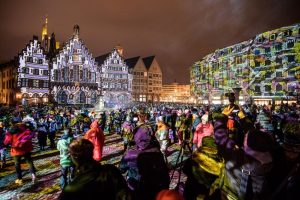
Glass gobos offer unlimited color options
Glass gobos also open up grayscale and full color options so you can utilize your brand colors for a more striking projection. Projections today can be true works of art, transforming building facades and interiors with color palettes as rich and varied as a painter’s canvas.
Durability & longevity
Some customers believe metal gobos are more durable than glass. This doesn’t hold true, however, if the design is overly complex. Remember, metal gobos are like stencils, so the more intricate the design, the less metal remains holding the gobo together (thus the need for tabbing). Additionally, in hot fixtures, such as theatrical projectors with halogen lamps, the thin metal structures tend to warp and wear over time. The etching process used for glass means that the gobo remains intact, producing a gobo you can reuse for years in any projector. Even if you only plan to use your glass gobo once, many customers like to save custom gobos, especially monogram gobos, as a keepsake of their special day.
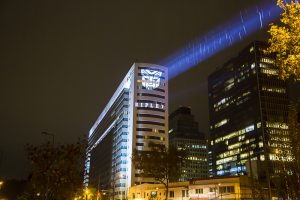
Size doesn’t matter
Glass also works well with smaller gobos, regardless of the intricacy of the design, allowing you to utilize a more compact, budget-conscious projector. The size of the resulting projection also doesn’t effect the brilliance or definition of the image quality. You can use a glass gobo for a modest logo projection in your front entryway or to create billboard-size projections for product advertising and brand awareness campaigns.
Related post: Must-Try Alternatives to Billboard Advertising
Metal Gobos
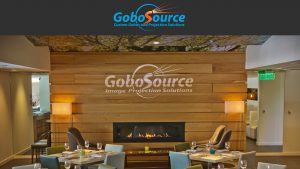
Best for simple, single-color line art
Metal gobos are a good choice for simple black and white or single color line art as well as text that won’t be compromised with tabbing. Metal can also accommodate more complex artwork but mainly in larger gobo sizes and with slight modifications that will change the overall look of your artwork.
Metal gobos are cheaper up front
We have a wide variety of metal stock gobos or we offer custom metal gobos for those seeking a less expensive option, but the lower cost comes at a price. Compared to glass, your design options and sizes are limited when you choose a metal gobo.
Limited color palette
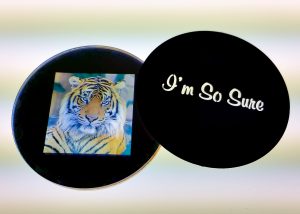
Full color glass gobo on the left versus a metal gobo with tabbing on the right.
You may not always need a full-color glass gobo depending on your design and application. If you’re happy with a black and white design with tabbing, then a metal gobo will meet your needs. You can also purchase a color filter for a single-color design but you can’t achieve color gradation or accommodate more than one color. Regardless of how many colors your design requires, a metal gobo cannot beat the sharp image quality of a glass gobo projection. That’s why we always recommend upgrading to glass if your budget allows.
Film Gobos
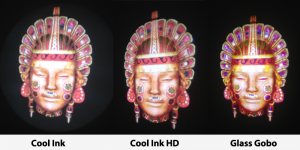
Full-color film gobos are less saturated than a glass gobo.
Your short-term, low-cost projection solution
Film gobos can accommodate both simple line art and more complex, full color designs and is the least expensive option with the shortest lead time. So why wouldn’t you always just go with film? While film gobos can be the right solution for some customers, there are a few downsides to this material.
The limitations of film gobos
A film gobo can be a last minute, short-term solution for certain single-use applications, but be aware that they’re not as reliable as metal or glass gobos. Film gobos only work in a very limited number of projectors (if the wattage is too high, the film gobo will melt) so you should always consult with the projector manufacturer first to ensure film gobos are an option.
Low heat-resistance and a short lifespan – it’s complicated
The limited heat resistance of film not only limits your projector options, it also greatly reduces the lifespan of the gobo compared to glass and metal. Always check if your projector is suitable for film gobo use.
When using stronger projectors, the lifespan of a film gobo may be just a few hours. You can extend the lifespan to over a week by using a typical 10 watt LED projector but this will greatly limit the brightness of your projection. Most of the first generation LED projectors accommodated film gobos, because of their relatively low light output. Modern LED fixtures, however, put out much more lumens per watt, which also means much more heat, and too much heat is a problem for film gobos.
The gobo image size also plays a role in the amount of heat a film gobo can handle. The smaller the gobo size, the more heat is concentrated on the film surface. For example, our 25W ECO Spot C25, which takes an E-size gobo (25mm in image diameter) must be dimmed down to 50% for use with a film gobo. Even at just 50% brightness, the film gobo will only last for an evening. The significantly stronger 90W ECO Spot B90, however, allows for up to 8 hours of film life. This is because the B90 uses an M-size gobo, significantly larger at 48mm in image diameter than the E-size gobo. The lifespan is also affected by the amount of cooling air flow around the gobo.
In comparison, metal and glass gobos can last much longer, even with regular use. In dry environments, a glass gobo lasts for many years, even when used 24/7.
Less vibrant projections
If your artwork is in color, a film gobo projection can work but it will be noticeably duller than glass gobos. Although some companies boast film or transparency gobos that produce projections comparable to glass, you simply can’t have the same clarity and brilliance with film. This is because film lets a significant amount of light through, muting contrast. The way colors are physically generated in film is also far inferior to dichroic glass gobos. Plus, you’re limited to low-wattage projectors, which produce less brightness.
The ability to use high-wattage projectors combined with the accuracy and clarity of the laser etching process on dichroic glass, guarantees bolder and more vibrant colors with a glass gobo, even in brightly lit environments. Last but not least, smaller designs may also appear pixelated with a film gobo, which isn’t an issue with metal or glass.
Why glass gobos are often the best choice
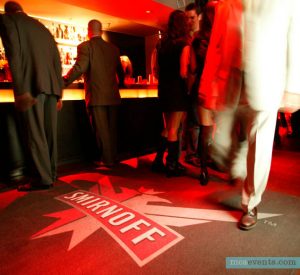
We always encourage our customers to upgrade to a glass gobo because it guarantees the best quality projection for any style of design or application. There are some simple designs that translate well to a metal gobo but you will always find more flexibility with glass. A glass gobo works with any projector and will produce the same quality results whether it’s a projection the size of a serving platter or a football field. You’re not limited to simple designs and a single color. You’re also rarely required to accept modifications to your original artwork.
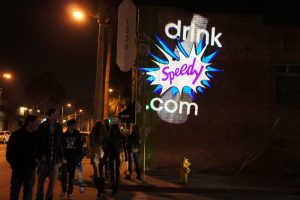
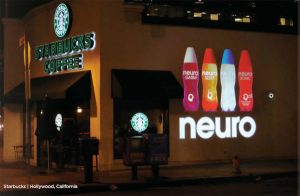
For all these reasons, we believe glass gobos are most often the best choice for your gobo projections. If you still have questions about which gobo is the best fit for your particular needs, don’t hesitate to reach out to our sales team at 831-431-8801 or 1-800-213-1092. We’re happy to help!
Want to make sure you don’t miss new product releases, gobo lighting tips, and special deals? Subscribe to our Newsletter
